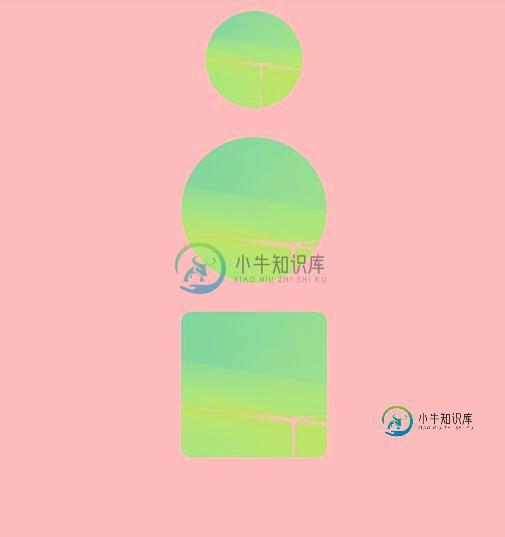Android自定义View圆形图片控件代码详解
前言
在日常开发中,圆形的图片效果还是很常见的。可以通过给Paint设置Xfermode来实现,这里简单记录如下。
实现
实现圆形效果的核心是PorterDuffXfermode,对于PorterDuffXfermode,这里不展开,可以查询相关资料。
核心代码
//绘制背景
canvas.drawCircle(mSize / 2, mSize / 2, mSize / 2, mPaint);
//设置模式为:显示背景层和上层的交集,且显示上层图像
mPaint.setXfermode(new PorterDuffXfermode(PorterDuff.Mode.SRC_IN));
//绘制要显示的图像
canvas.drawBitmap(mSrcBitmap, 0, 0, mPaint);
//重置Xfermode
mPaint.setXfermode(null);
自定义属性
<?xml version="1.0" encoding="utf-8"?>
<resources>
<declare-styleable name="CircleView">
<!--定义资源-->
<attr name="src" format="reference" />
<!--定义类型-->
<attr name="type" format="enum">
<!--圆形-->
<enum name="round" value="1" />
<!--矩形-->
<enum name="rect" value="2" />
</attr>
</declare-styleable>
</resources>
自定义控件
public class CircleView extends View {
private static final int DEFAULT_SIZE = 200;
private static final int DEFAULT_RADIUS = 20;
private static final int TYPE_ROUND = 1;
private static final int TYPE_RECT = 2;
private int mSize;
private int mResourceId;
private int mType;
private Paint mPaint;
private Bitmap mSrcBitmap;
public CircleView(Context context) {
this(context, null);
}
public CircleView(Context context, AttributeSet attrs) {
this(context, attrs, 0);
}
public CircleView(Context context, AttributeSet attrs, int defStyleAttr) {
super(context, attrs, defStyleAttr);
TypedArray ta = context.obtainStyledAttributes(attrs, R.styleable.CircleView);
mResourceId = ta.getResourceId(R.styleable.CircleView_src, R.mipmap.ic_launcher);
mType = ta.getInt(R.styleable.CircleView_type, TYPE_ROUND);
ta.recycle();
init();
}
@Override
protected void onMeasure(int widthMeasureSpec, int heightMeasureSpec) {
int width = getMeasureSize(widthMeasureSpec);
int height = getMeasureSize(heightMeasureSpec);
mSize = Math.min(width, height);
setMeasuredDimension(mSize, mSize);
}
@RequiresApi(api = Build.VERSION_CODES.LOLLIPOP)
@Override
protected void onDraw(Canvas canvas) {
super.onDraw(canvas);
//绘制背景
if (mSrcBitmap == null) {
mSrcBitmap = getScaleBitmap();
}
if (mType == TYPE_ROUND) {
canvas.drawCircle(mSize / 2, mSize / 2, mSize / 2, mPaint);
} else if (mType == TYPE_RECT) {
canvas.drawRoundRect(0, 0, mSize, mSize, DEFAULT_RADIUS, DEFAULT_RADIUS, mPaint);
}
//设置模式为:显示背景层和上层的交集,且显示上层图像
mPaint.setXfermode(new PorterDuffXfermode(PorterDuff.Mode.SRC_IN));
//绘制要显示的图像
canvas.drawBitmap(mSrcBitmap, 0, 0, mPaint);
//重置Xfermode
mPaint.setXfermode(null);
}
private void init() {
//禁用硬件加速,否则可能无法绘制圆形
setLayerType(LAYER_TYPE_HARDWARE, null);
mPaint = new Paint();
mPaint.setAntiAlias(true);
mPaint.setStyle(Paint.Style.FILL);
}
private int getMeasureSize(int measureSpec) {
int mode = MeasureSpec.getMode(measureSpec);
int size = MeasureSpec.getSize(measureSpec);
return mode == MeasureSpec.EXACTLY ? size : DEFAULT_SIZE;
}
/**
* 获取缩放后的Bitmap
*
* @return
*/
private Bitmap getScaleBitmap() {
BitmapFactory.Options options = new BitmapFactory.Options();
options.inJustDecodeBounds = true;
BitmapFactory.decodeResource(getResources(), mResourceId, options);
options.inSampleSize = calcSampleSize(options, mSize, mSize);
options.inJustDecodeBounds = false;
return BitmapFactory.decodeResource(getResources(), mResourceId, options);
}
/**
* 计算缩放比例
*
* @param option
* @param width
* @param height
* @return
*/
private int calcSampleSize(BitmapFactory.Options option, int width, int height) {
int originWidth = option.outWidth;
int originHeight = option.outHeight;
int sampleSize = 1;
while ((originWidth = originWidth >> 1) > width && (originHeight = originHeight >> 1) > height) {
sampleSize = sampleSize << 1;
}
return sampleSize;
}
}
注意:如果没有圆形的效果,那么可能需要禁用硬件加速:setLayerType(LAYER_TYPE_HARDWARE, null)
布局
<?xml version="1.0" encoding="utf-8"?> <LinearLayout xmlns:android="http://schemas.android.com/apk/res/android" xmlns:app="http://schemas.android.com/apk/res-auto" xmlns:tools="http://schemas.android.com/tools" android:layout_width="match_parent" android:layout_height="match_parent" android:gravity="center_horizontal" android:orientation="vertical" tools:context=".MainActivity"> <com.wangyz.custom.CircleView android:layout_width="wrap_content" android:layout_height="wrap_content" android:layout_margin="10dp" app:src="@drawable/image" /> <com.wangyz.custom.CircleView android:layout_width="100dp" android:layout_height="100dp" android:layout_margin="10dp" app:src="@drawable/image" /> <com.wangyz.custom.CircleView android:layout_width="100dp" android:layout_height="100dp" android:layout_margin="10dp" app:src="@drawable/image" app:type="rect" /> </LinearLayout>
效果

以上就是本文的全部内容,希望对大家的学习有所帮助,也希望大家多多支持小牛知识库。
-
本文向大家介绍Android自定义控件之圆形/圆角的实现代码,包括了Android自定义控件之圆形/圆角的实现代码的使用技巧和注意事项,需要的朋友参考一下 一、问题在哪里? 问题来源于app开发中一个很常见的场景——用户头像要展示成圆的: 二、怎么搞? 机智的我,第一想法就是,切一张中间圆形透明、四周与底色相同、尺寸与头像相同的蒙板图片,盖在头像上不就完事了嘛,哈哈哈! 在背景纯色的前提下,这的
-
本文向大家介绍Android自定义控件之圆形、圆角ImageView,包括了Android自定义控件之圆形、圆角ImageView的使用技巧和注意事项,需要的朋友参考一下 一、问题在哪里? 问题来源于app开发中一个很常见的场景——用户头像要展示成圆的: 二、怎么搞? 机智的我,第一想法就是,切一张中间圆形透明、四周与底色相同、尺寸与头像相同的蒙板图片,盖在头像上不就完事了嘛,哈哈哈! 在背景纯
-
本文向大家介绍Android自定义View——扇形统计图的实现代码,包括了Android自定义View——扇形统计图的实现代码的使用技巧和注意事项,需要的朋友参考一下 Android 扇形统计图 先看看效果: 看上去如果觉得还行就继续往下看吧! 自定义View 定义成员变量 测量宽高 画图 画扇形 一个圆形统计图是由许多个扇形组成的,我们根据数据计算出每个扇形的角度即可。注意,画弧度的时候,角度是
-
本文向大家介绍详解Android自定义View--自定义柱状图,包括了详解Android自定义View--自定义柱状图的使用技巧和注意事项,需要的朋友参考一下 绪论 转眼间,2016伴随着互联网寒冬和帝都的雾霾马上就过去了,不知道大家今年一整年过得怎么样?最近票圈被各个城市的雾霾刷屏,内心难免会动荡,庆幸自己早出来一年,也担忧着自己的未来的职业规划。无所谓了,既然选择了这个行业,我觉得大家就应该坚
-
本文向大家介绍Android自定义View详解,包括了Android自定义View详解的使用技巧和注意事项,需要的朋友参考一下 转载请标明出处:http://blog.csdn.net/lmj623565791/article/details/24252901 很多的Android入门程序猿来说对于Android自定义View,可能都是比较恐惧的,但是这又是高手进阶的必经之路,所有准备在自定义Vi
-
本文向大家介绍Android自定义控件实现圆形进度条,包括了Android自定义控件实现圆形进度条的使用技巧和注意事项,需要的朋友参考一下 项目中常用到的圆形进度条有好多个,从网上搜到的自定义进度条多是封装的比较好的代码,但是不利于初学者,现在本博客就教给大家如何一步步实现自定义进度条的效果: 先看效果如图… 代码实现过程–main布局 这个布局中就是一个简单的引用 自定义ProgressView

